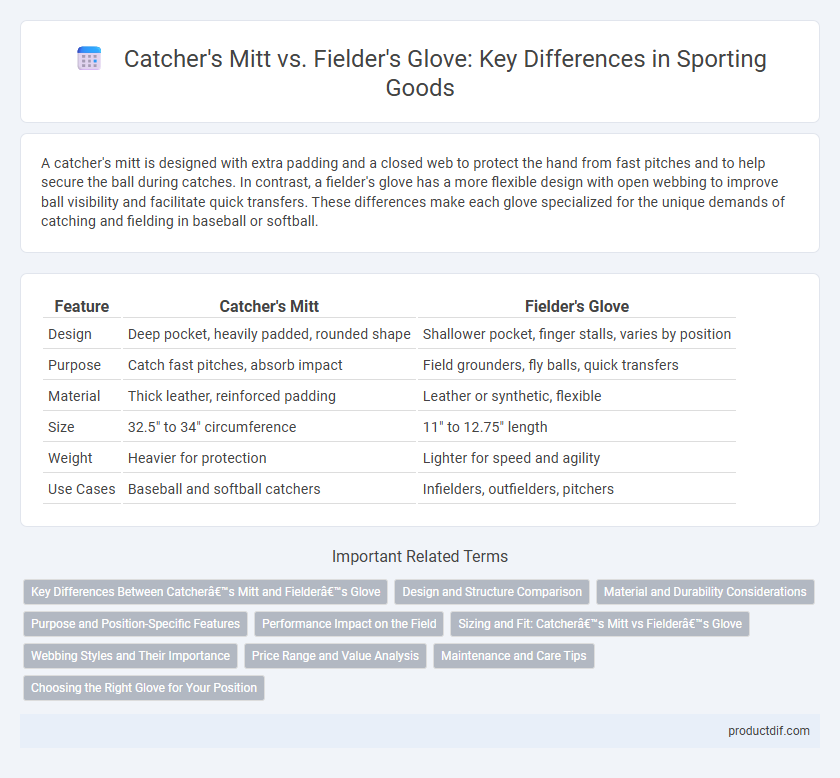A catcher's mitt is designed with extra padding and a closed web to protect the hand from fast pitches and to help secure the ball during catches. In contrast, a fielder's glove has a more flexible design with open webbing to improve ball visibility and facilitate quick transfers. These differences make each glove specialized for the unique demands of catching and fielding in baseball or softball.
Table of Comparison
| Feature | Catcher's Mitt | Fielder's Glove |
|---|---|---|
| Design | Deep pocket, heavily padded, rounded shape | Shallower pocket, finger stalls, varies by position |
| Purpose | Catch fast pitches, absorb impact | Field grounders, fly balls, quick transfers |
| Material | Thick leather, reinforced padding | Leather or synthetic, flexible |
| Size | 32.5" to 34" circumference | 11" to 12.75" length |
| Weight | Heavier for protection | Lighter for speed and agility |
| Use Cases | Baseball and softball catchers | Infielders, outfielders, pitchers |
Key Differences Between Catcher’s Mitt and Fielder’s Glove
Catcher's mitts feature extra padding and a closed web design to absorb high-velocity pitches and provide maximum durability, while fielder's gloves are generally lighter with varied web patterns to enhance flexibility and ball control during catches. The shape of a catcher's mitt is more rounded with a larger pocket to secure fast pitches, whereas fielder's gloves are longer and narrower to facilitate quick transfers and precise handling of fly balls or grounders. These design differences accommodate the unique demands of catching behind the plate versus fielding in the infield or outfield positions.
Design and Structure Comparison
A catcher's mitt features extra padding and a closed web design to provide maximum protection and durability while securely catching fast pitches. In contrast, a fielder's glove is lighter with a more flexible, open web structure to enhance ball control and facilitate quick transfers during fielding. The catcher's mitt typically has a rounder, deeper pocket, whereas the fielder's glove offers a shallower pocket for quicker ball retrieval and throwing.
Material and Durability Considerations
Catcher's mitts are typically made from thicker, more durable leather such as full-grain steerhide to withstand frequent high-impact catches and provide extra padding, enhancing longevity. Fielder's gloves often use lighter, more flexible materials like kip leather to maximize agility and control during quick plays, balancing durability with mobility. The robust construction of catcher's mitts ensures long-term resilience under intense use, whereas fielder's gloves prioritize a blend of durability and lightweight design for optimal performance.
Purpose and Position-Specific Features
Catcher's mitts are designed with extra padding and a closed web to absorb high-velocity pitches and provide a larger target, optimized for the catcher's position behind the plate. Fielder's gloves vary by position, featuring longer fingers and open webbing for outfielders to improve ball visibility and quick transfers, while infielders use smaller, more flexible gloves for rapid ball handling. Position-specific features enhance performance by tailoring glove shape, size, and webbing to the unique demands of catching versus fielding.
Performance Impact on the Field
A catcher's mitt features extra padding and a closed web design, providing superior protection and allowing for quick, secure catches of fast pitches, which significantly enhances defensive reliability behind the plate. In contrast, a fielder's glove is lighter, with a more flexible webbing and deeper pocket, enabling faster ball transfers and better control when fielding grounders or making throws, ultimately improving infield and outfield range and agility. Choosing the right glove directly affects a player's fielding efficiency, reaction time, and overall defensive performance during a game.
Sizing and Fit: Catcher’s Mitt vs Fielder’s Glove
Catcher's mitts typically range from 32.5 to 34 inches in circumference, designed with extra padding and a closed web to provide protection and support for catching fast pitches. Fielder's gloves vary by position, generally measuring 11 to 13 inches, with outfield gloves being longer for greater reach and infield gloves having a shallower pocket for quick ball transfer. Proper sizing and fit are crucial for performance; catchers need a snug, well-padded mitt to absorb impact, while fielders benefit from a glove tailored to their position-specific movements and hand size.
Webbing Styles and Their Importance
Catcher's mitts feature a closed, heavily padded webbing style, typically a hinged or hinged trapeze design, crucial for securing fast pitches and providing maximum protection. Fielder's gloves utilize varied webbing styles like single post, H-web, or modified trapeze, enhancing flexibility, visibility, and control for catching line drives and ground balls. Webbing style directly affects glove performance by balancing durability, flexibility, and the ability to quickly transfer the ball during play.
Price Range and Value Analysis
Catcher's mitts typically range from $80 to $300, reflecting specialized padding and durable construction designed to handle high-impact catches, offering superior protection and longevity for serious players. Fielder's gloves are usually priced between $50 and $250, balancing lightweight flexibility and webbing options to enhance ball control and agility in the field. Investing in a catcher's mitt provides enhanced durability and impact resistance, while fielder's gloves offer versatile performance at a generally lower cost, making value dependent on position-specific requirements.
Maintenance and Care Tips
Catcher's mitts require regular cleaning and conditioning to maintain their flexibility and prevent leather cracking, with special attention to the heavily padded areas that endure frequent impact. Fielder's gloves benefit from routine oiling and reshaping to preserve their pocket and ensure optimal ball control during catches. Storing both types of gloves in a cool, dry place and avoiding prolonged exposure to moisture significantly extends their lifespan and performance.
Choosing the Right Glove for Your Position
Choosing the right glove for your position is crucial in baseball for optimal performance. A catcher's mitt is designed with extra padding and a closed web to handle fast pitches and protect the hand, while a fielder's glove is lighter with an open web to allow quicker ball transfers and improved catching flexibility. Selecting a glove tailored to your specific role enhances grip, control, and overall fielding efficiency.
Catcher’s mitt vs Fielder’s glove Infographic

 productdif.com
productdif.com